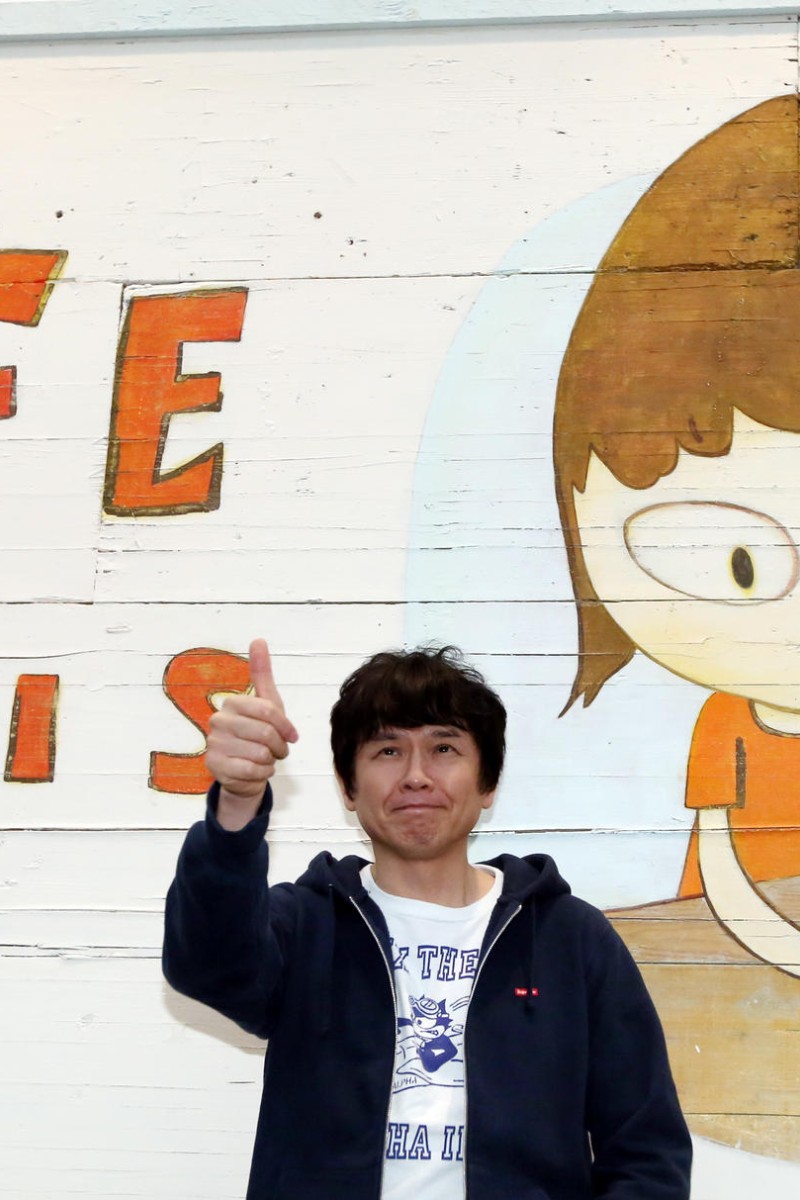 Crowds lined up to hear artist Yoshitomo Nara.
Crowds lined up to hear artist Yoshitomo Nara.At Yoshitomo Nara’s studio in Japan, it’s always exactly 4.39. The batteries in his clock died years ago, and he’s never replaced them. His desk and the shelves around it are littered with memorabilia he’s collected over the years, reminding him of his past and how far he has come.
It was this personal journey that Nara was sharing with the packed lecture hall at the Asia Society Hong Kong, which is holding his first major solo exhibition in Hong Kong, called Life is Only One.
Sitting calmly on stage, the artist clicked through a collection of slides and images from his childhood and artwork, telling personal stories and his own thought process, speaking in his native Japanese with simultaneous translation into English and Cantonese.
The first selection of photographs showed the small northern Japanese town of Hirosaki, where Nara was born and grew up. The black and white photos showed hard work by farmers, and a difficult environment. “If you sleep outside, of course you die,” explained Nara. “That’s how harsh the winter is.”
Nara’s own childhood was lonely. “When I was a child, I really liked cats,” he says. “In my neighbourhood, I didn’t have a friend my age. When I came home [after school] I was alone … So I always played with cats.”
The artist has come a long way from a lonely childhood playing with cats and dreaming of being a fisherman. His artwork has taken him all over the world, and given him and international cult following. Still, Nara seems more surprised by his fame than anything. “I don’t really consider myself an artist,” he laughs. “I always drew and painted so I could travel.”
But his paintings of wide-eyed children and playful sculptures of dogs have caught the attention of collectors and fans. His lecture at Asia Society was so popular, a separate lecture hall had to be opened to accommodate the overflow of crowds who filled the room just to hear a live stream of his talk. And Nara seems just as excited by his experiences as the audience is to hear them.
“Can I brag about myself?” Nara asks the audience. “Yes, I’m going to,” he announces as he proudly brings up a picture of himself alongside actress Lucy Liu. Staring at the photo projected on the screen, Nara looks as star-struck as any fan in the audience.
He’s hesitant to acknowledge his own fame. “I’m not a professional artist, I’m an amateur,” he insists. “It’s my hobby.” But just last year, one of his works – Night Walker – sold at auction in Hong Kong for HKD$15.6 million. With numbers like those, major exhibitions across the globe, and packed lecture rooms, it’s hard to deny his success.
There’s something that draws people into his art, but if you ask him about it, he’s not sure why. “Sometimes I get the question: ‘What does your art mean?’ But I don’t know how to answer that.”
Simplicity can be deceiving, and while Nara’s end product looks refined and clean, the painting process can be messy and difficult. But if it looks easy, then he knows he’s done his work well. “Some people say: ‘My kid can draw this.’ When I hear this I get very angry,” he says. “You may think these paintings are done very simply or very quickly, but this is not the case. I have to think about many things.”
17-year-old artist Rainbow Tse provides a unique view of Hong Kong in her paintings
He turns to a series of photos showing his process on one painting. The first picture shows a simple outline of a girl, covered with splotches of different colour. “Basically, I don’t really think about anything,” he says of the first stage, “I just put on the colours. It’s quite playful.” As he clicks through the photos, the painting comes more into focus as he decides on colours and hones in on details like the hair and the eyes. Sometimes these details cause him to repaint again and again, until he gets it exactly perfect. “If I had better imagination, I wouldn’t have to waste my time re-doing things,” he jokes.
But sometimes all the difficulty is worthwhile. “The pieces I struggled with, with so many amendments and corrections … I usually like them better,” he says.
Throughout the talk, Nara remains humble, apologising when he can’t think of the right words to express his ideas. “I’m trying to speak to you, trying to communicate, but I’m not very good at communicating,” he explains. “That’s why I go to the picture, to my drawings.”
Life is Only One is showing free to the public until July 26 at Asia Society.
